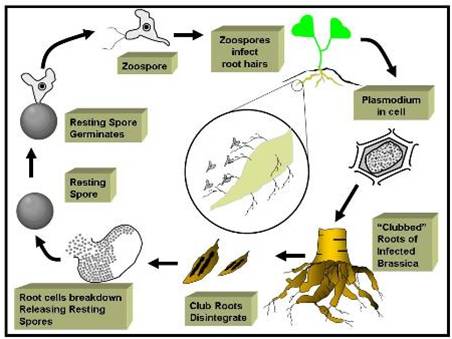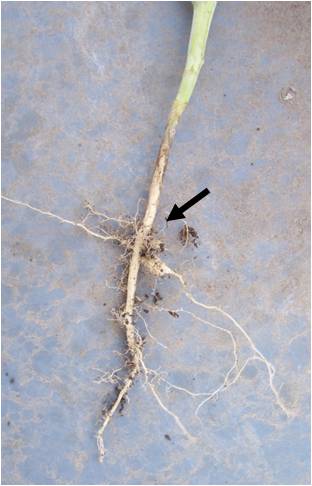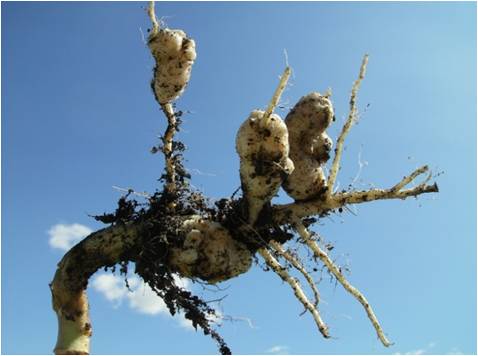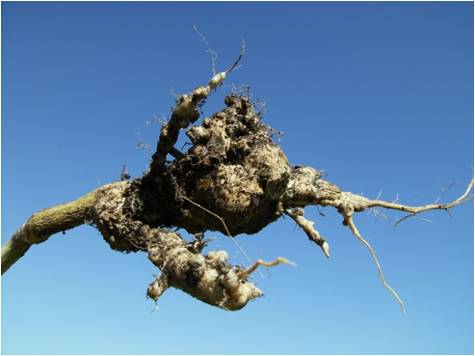Clubroot Of Canola: The Facts
Background
Clubroot, caused by Plamodiophora brassicae, is a serious disease of cruciferous crops including canola, mustard, cabbage, cauliflower, broccoli, and rutabaga.
The first case of visible clubroot symptoms in a canola field was in 2003, near Edmonton, Alberta. Since the initial detection, clubroot has spread to more than 1,500 fields in Alberta. In Saskatchewan, two confirmed symptomatic cases of clubroot were found in 2011 in the north-central part of the province. There have been no reported cases in Saskatchewan since 2011.
In Manitoba, clubroot symptoms of low severity were observed in a canola nursery in 2005. Continued testing after the 2005 case, has shown no further presence of clubroot in the soil or on plants. In 2013, two fields in Manitoba were identified and confirmed as showing clubroot symptoms in-crop. In addition, the presence of clubroot DNA has been detected in multiple fields. For more information on the location of rural municipalities identified as positive for clubroot in the soil and/or plant tissues, please refer to the Manitoba Clubroot Map.
The Pathogen
Clubroot resting spores can survive in the soil for as long as twenty years (Fig.1). These spores are released from the galls that form on the roots of susceptible hosts after infection. The spores germinate to produce zoospores which infect the root hairs of the next susceptible plants grown in the soil. Germination occurs over a wide temperature range of 12 to 27°C, but disease development is favoured by high soil moisture and soil temperatures between 18 and 25°C. Clubroot is generally associated with more acidic soils, but has been identified in soils that range in pH from 4.5 to 8.1.

Figure 1. Disease life cycle of clubroot caused by Plasmodiophora brassicae
As with any root disease, the aboveground symptoms include wilting, stunting, chlorosis of leaf tissue, and premature ripening. The symptoms indicate that the plant is undergoing water and nutrient stress due to a problem with the root system.
The belowground symptoms differentiate clubroot from other root diseases. Roots of clubroot-infected plants will form galls and swellings, giving them a club-shaped appearance. Initially, the galls will be firm and white on the inside (Figs.2,3), but as they mature they turn peat brown and begin to decompose (Fig.4).

Figure 2. Canola plant showing low severity clubroot symptoms (arrow). Photo courtesy of the Canola Council of Canada.

Figure 3. Canola roots moderately infected with clubroot. Photo courtesy of the Canola Council of Canada.

Figure 4. Canola roots with advanced clubroot galls that are beginning to decompose. Photo courtesy of the Canola Council of Canada.
Management
Clubroot is spread through movement of infested soil. Therefore, reducing soil movement through proper sanitation is crucial in preventing/limiting the spread of clubroot on and between farms. Most soil is transferred on farm equipment such as tractors and cultivators, but vehicles, boots, tools, and storage containers can also carry enough soil to spread the clubroot pathogen.
Equipment sanitation can be performed at different levels on the farm. The most basic involves a rough cleaning of equipment to remove loose and clinging soil and crop debris. Using a wire brush and/or compressed air will remove approximately 90% of the soil from the unit. The second level involves washing off equipment with a pressure washer. The combination of the first two steps removes approximately 99% of the soil and debris from the unit. The third and most intensive level recommends misting the equipment with a weak disinfectant such as a 1% bleach solution.
Other techniques to reduce the spread of infested soil include working infested fields last, not working fields when the soil is wet, ensuring custom operators follow sanitation practices, and using reduced tillage practices.
Along with reducing soil movement, crop rotations of at least three years between canola crops, and good weed management of alternate hosts, such as stinkweed, shepherd’s purse, and wild mustard, will decrease the likelihood of clubroot establishing in a field. In addition, these techniques will prevent heavier infestations from developing where clubroot is already present at low or undetected levels. The use of clubroot resistant varieties is an important part of an integrated pest management plan when clubroot has been confirmed in your area.
With all disease issues scouting is one of the most important management tools a grower can use. Symptoms of clubroot are often initially observed at the entrance to a field, so basic scouting should be done at these locations. Growers should consider situations where transfer of soil may have occurred such as the purchase of used field equipment, the use of custom operators, or traffic from recreational vehicles. If suspicious symptoms are observed plant samples can be sent to the Manitoba Agriculture Crop Diagnostic Centre.
Methods of Detection
Confirmation of a positive clubroot case requires both disease symptoms in a susceptible crop and the detection of the pathogen’s DNA in a plant or a soil sample. In Manitoba, if a soil sample is positive for the clubroot DNA, but no field symptoms are observed on plants, the case is termed a ‘non-symptomatic field of concern’ and further monitored (Table 1).
Table 1. Terminology for different types of clubroot cases based on field symptoms and lab testing for DNA.
| Term | In-Field Symptoms | DNA Test |
|---|---|---|
| Positive Clubroot Case | Yes | Yes |
| Non-Symptomatic Field of Concern | No | Yes |
| Clubroot Not Detected | No | No |
Lab techniques for detecting clubroot DNA in the soil have improved significantly over the last number of years and some labs can accurately detect the DNA at concentrations of 1000 spores per gram of soil or lower. It is generally reported that approximately 100,000 spores per gram of soil are required to cause disease symptoms to show up under field conditions. Under highly conducive conditions, symptoms may be observed with lower concentrations. In areas of Alberta where clubroot has proliferated concentrations reach more than 10 million spores per gram of soil. At this time, little research has been conducted in fields where clubroot concentrations are extremely low, but it is important to note that the distribution of the pest in these fields can be highly variable.
Resources
Canola Council of Canada Clubroot Website

